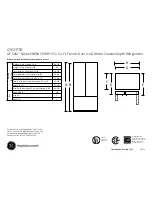
EN-4
For uneven surfaces, front feet can be aligned.
AMBIENT TEMPERATURE
This appliance is designed to operate in ambient temperature between 16°C and
43
°C.
If these temperatures are exceeded, i.e. colder or warmer, the
appliance will not operate correctly. If the ambient temperatures are exceeded for long periods, the temperature in the freezer compartment will rise
above -18
℃
and food spoilage may occur.
BEFORE PLACING FOOD IN THE APPLIANCE
Remove all packaging.
Allow the appliance to run empty for 2 – 3 hours so the compartments can cool to the appropriate temperature.
Clean the inside of the appliance with warm water and a little liquid detergent to remove manufacturing and transportation dust.
POWER FAILURE
If there is a power failure, do not open the door. Frozen food should not be affected if the power failure lasts for less than 1
8
h ours.
Do not refreeze frozen foods that have thawed completely. The food may be dangerous to eat.
TEMPERATURE CONTROL
There is a temperature control knob located inside the fridge compartment. Adjust the control knob as desired to suit your individual preference.
0 is off setting – stop cooling
1 is cold setting
7 is coldest setting
The running time and temperature are affected by where the fridge freezer is located, how often the door is opened and the temperature of the room
the fridge freezer is located in.
When you use the appliance for the first time or after defrosting, adjust the control knob to the coldest setting for at least 2 hours before introducing
food to be stored, and then readjust to the middle setting.
MOVING YOUR APPLIANCE
If the appliance is turned off for any reason, wait for 10 minutes before turning it back on. This will allow the refrigeration system pressures to equalise
before restarting.
Turn off the appliance and unplug it from the mains socket. Remove all food. Also remove all mobile parts (shelves, accessories, etc.) or fix them into the
appliance to avoid any shock.
Relocate and install. If the appliance has been left on its side for any length of time, leave it standing upright for at least 10 minutes before turning on.
Your appliance uses isobutane (R600a) as a refrigerant. Although R600a is an environmentally friendly and natural gas, it is explosive. Therefore you
should be careful during shipment and installation to prevent your appliance’s cooler elements from being damaged. In the event of a leak caused by
damage to the cooler elements, move your appliance from open flame or heat sources and ventilate the room where the appliance is located for a few
minutes.
STORING FOOD IN THE FRIDGE COMPARTMENT
The fridge compartment helps to extend the storage times of fresh perishable foods.
Fresh food care
For best results:
Store foods that are very fresh and of good quality.
Ensure that food is well wrapped or covered before it is stored. This will prevent food from dehydrating, deteriorating in colour or losing taste and will
help maintain freshness. It will also prevent odour transfer.
Make sure that strong smelling foods are wrapped or covered and stored away from foods such as butter, milk and cream which can be tainted by
strong odours.
Cool hot foods down before placing them in the fridge compartment.
Dairy foods and eggs
Most pre-packed dairy foods have a recommended ‘use by /best before/best by/’ date stamped on them. Store them in the fridge
compartment and use within the recommended time.
Butter can become tainted by strong smelling foods so it is best stored in a sealed container.
Eggs can be stored in the egg tray of the fridge compartment.
Red meat
Place fresh red meat on a plate and loosely cover with waxed paper, plastic wrap or foil.
Store cooked and raw meat on separate plates. This will prevent any juice lost from the raw meat from contaminating the cooked
product.
Poultry
Fresh whole birds should be rinsed inside and out with cold running water, dried and placed on a plate. Cover loosely with
plastic wrap or foil.
Poultry pieces should also be stored this way. Whole poultry should never be stuffed until just before cooking, otherwise food
poisoning may result.
Fish and seafood
Whole fish and fillets should be used on the day of purchase. Until required, refrigerate on a plate loosely covered with
Summary of Contents for PLC234SL
Page 13: ...FR 10...
















































